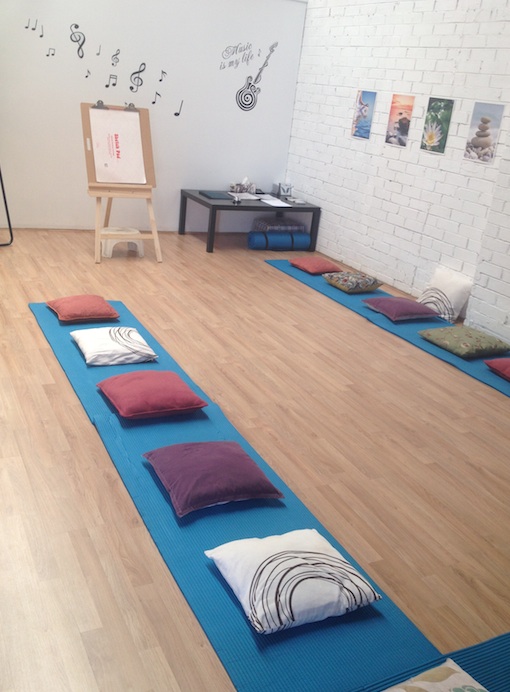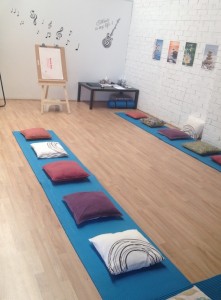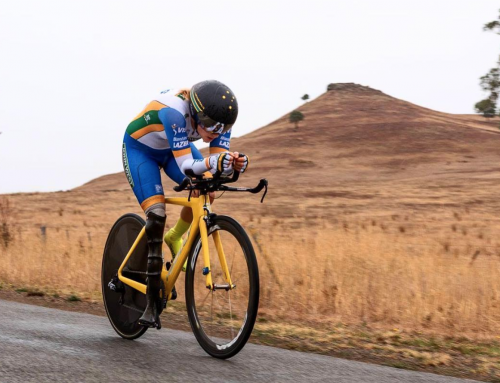Being the uncultured Melbournian that I am, instead of watching the Grand Final I was packing my bags and heading to a 5hr meditation workshop run by BMS Rivers. I know, I can hear you all scoffing but when you grow up with a parent who has no interest in the sport (or really any sport), my fate had already been sealed.
I was fresh with no expectations except learning about five different mediation techniques and putting them into practice. The session began with busting some meditation myths –
Myth 1: You need to have your eyes closed
Fact: There are multiple meditation styles and techniques, in fact, the Buddha taught 84 different ways to do mindfulness alone. Candle and walking meditations are examples that bust this myth; have you ever felt the power of the flames around a campfire and felt yourself get lost in their mesmerizing dance?
Myth 2: I have to meditate for 30minutes every day
Fact: You need to drop your expectations of time and do meditation without an alarm so you can become in tune with your body. Every day will be different. Some days you may only need five minutes of meditation, other days it could be hours! At the very least though, aim for five minutes per day to start receiving the health benefits of meditation.
So what exactly is meditation?
Meditation is essentially training the mind. The mind by nature is designed to think, plan, remember, devise, communicate etc etc. However, the mind is like a naughty child. It will push you until either you give in or until it learns to do what it is told. Meditation will help you train your mind to do what it is told! A word of caution to this tale, there is no need to hate on the mind, it is simply doing what it is designed to do. We need to accept the multiple parts in order to appreciate the stillness mediation offers. For example, we cannot appreciate happiness without knowing sadness, we cannot appreciate joy having not encountered sorrow. Similarly, we cannot appreciate mediation without being aware of just how crazy that monkey up there can get sometimes… One other related note, YOU ARE NOT YOUR MIND. What do I mean by this? I mean that while you may have all these thoughts e.g. I am worthless after performing badly or I am amazing and totally look hot in this new yellow dress, our thoughts do not define who we are and what we stand for.
The Science Behind Meditation: 101
Let’s delve into some quick science behind meditation, and no, you don’t need to be Albert Einstein to understand how it all works! Our modern life has ensured that our sympathetic nervous system (i.e. our flight or fight response) is constantly switched on even though we are not in danger; personally I haven’t seen any dinosaurs roaming Bourke St recently… Add in the 21st century mod-cons of technology and out-of-control busy lifestyles, the result is similar to the analogy of plugging in too many appliances to a circuit board = circuit overload. It is the same principle for the brain. As such, the importance of balancing out our brain circuit overload is through activating our parasympathetic nervous system. When we activate the parasympathetic nervous system we ‘resting and digesting’ or ‘feeding and breeding’, i.e. we are digesting, increasing our sexual arousal etc etc.
The good news? Meditation kicks the parasympathetic nervous system into gear. Mediation also helps to create new neural pathways within our brains. Eons ago we used to think that the world was flat and that once we reached adulthood, we could no longer change our brains. Thankfully we now know that the brain is plastic, and we can continue to mould it till the day we die. We also know that neurons that fire together, wire together, in addition to our ‘use it or loose it’ system. So what does all this mean? The more we mediate, the stronger our ‘mediation’ pathways will be come. A great analogy is thinking of your brain like a computer. Using the internet, we establish cookies so that instead of typing ‘meditation’ in full, the second time we only have to type ‘medit’ before we get the full word come up. The third time, we only have to type ‘med’, the fourth time ‘me’, the fifth, ‘m’… Our brain is the same. For example, using a ‘stop’ approach (recognizing when you are having a limiting belief or putting yourself down), mentally and/or physically saying ‘stop’ helps to scratch the limiting self-belief record you have wired in your brain. This limiting belief takes between 30 and 45 days to change. So yes, it is bloody hard work! But the rewards? Everything from strengthening the brain to ending depression. Pretty big stuff.
Meditation Tips:
- How do you know if you are meditating correctly? If you are managing your mind, then you are meditating. If you are thinking, you are not meditating.
- The good news? No one has ever died or been harmed by meditation.
- If you sit with an open, upright posture, it is very difficult to have a negative thought. Body language is powerful. Make sure you adopt a meditation posture that will allow you to focus but not cause you pain.
- Do not put meditation on a pedestal. This has been one of my biggest mistakes and was my biggest take-away from the course. To be honest, after reading the book “Eat, pray, love’ and forming notions that mediation is a massive, cosmic experience where you will have blue light tingling all the way up and down you spinal cord, my expectations have been quite high. Thankfully I can now appreciate that I am not going to become Buddha in my next mediation session and can simply enjoy the calming experience without judging myself harshly.
- At the start of your meditation, being with phrase “I give myself permission to take this time for me. “ I also found the phrase “I give myself permission to not make lists” very powerful as this is typically what my brain is doing – it is planning and organizing.
A few meditation techniques that we covered:
- Concentration meditations where you can feel the breath, count the breath, name the breath (i.e. in/out), or focus the senses – what can you hear? What can you smell? What can you feel? What can you see? Concentration meditations are great for people suffering from anxiety or depression.
- Mindfulness meditations where you allow your thoughts to come and go without judgment i.e. think of your thoughts as trains whirring past, there is no need to board each and every train.
- Mantra meditations – can be used for healing and raising your vibration level.
- Chakra meditations – can be used for healing physically and emotionally.
- Loving kindness and affirmation mediations – can be used for healing and re-wiring of neural pathways if practiced for longer than 30 – 45 days.
At the end of the session I walked away with a renewed sense of peace – my mind felt relaxed and uncluttered. I was also very grateful for the experience to revisit some of my favourite topics such as positive psychology principles, neuro-linguistic-programming, Eastern tradition philosophies and how these all blend into relevance for us all. Sarah Rivers from BMS Rivers was a brilliant guide and presenter for the session, with a genuine authenticity and passion for helping introduce people to meditation. Not only does she run the 5hr meditation workshops, but you can also have meditation parties (I am sensing one on the horizon!). To conclude, I will finish with a quote from the workshop that really resonated with me, it is one that absolutely love as it incorporates the power of our attitudes –
“I don’t believe in problems, only situations”
Until next time,
Ride with a smile, ride with a purpose, ride in the moment,
Han









Leave A Comment